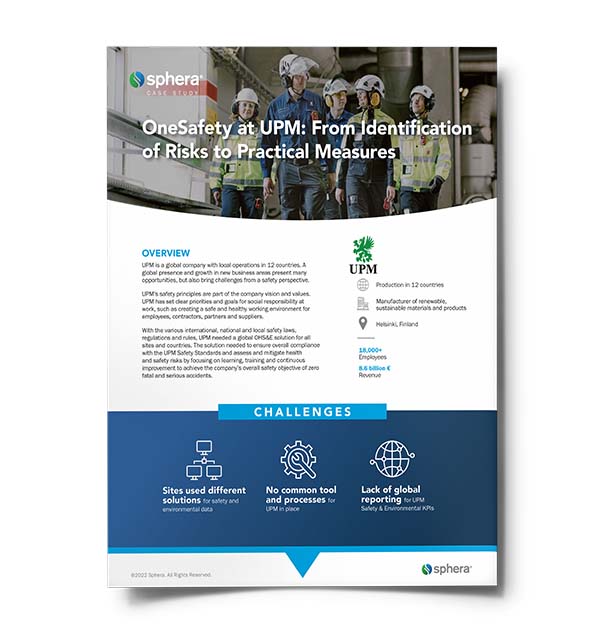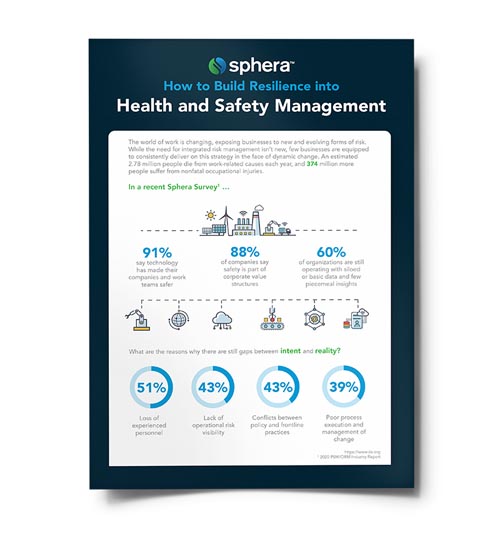Most large companies have begun their digitalization journey, with many deploying digital tools to improve safety in the workplace. While the pace of progress varies from company to company, many operational risk management (ORM) and process safety management (PSM) professionals believe that technology solutions offer a reliable way to improve safety. In fact, 96% of the ORM and PSM professionals surveyed for Sphera’s Safety Report 2022 agree that technology enables or has the potential to enable effective process safety and operational risk management.
What Are the Consequences of Not Digitalizing the Workplace?
Why digitalize? Manual processes are typically inefficient, and worse, can compromise safety. If companies are unaware of how multiple hazards interact, this could lead to a worst-case scenario with a major incident. Unfortunately, in hazardous industries, industrial explosions that cause multiple deaths and potentially billions in damages happen regularly. Negligence or a series of smaller incidents can and do lead to catastrophic events.
A digital transformation of ORM and PSM operations gives enterprises the ability to see the big picture and ensure greater transparency. The consequences of not having a shared view of the operational reality include safety risks, inefficiencies, downtime and loss of revenue. Regulatory risk and reputational damage are not far behind.

Overcoming Challenges to Implementation
While our survey respondents agree that technology can enable effective process safety and operational risk management, only 11% make full use of the technology solutions available to them. Many ORM and PSM professionals report that when implementing digital tools, the biggest challenge is their IT infrastructure. For companies beginning their digital transformation, here are key points to consider:
- Standardize operational process safety on location. With standardization at an administrative control level, companies can maintain documents such as plans, permits and workflows more efficiently.
- Identify differences among all the sites. It is worth the effort to try and reach a common denominator. Through standardized technology, documents can be distributed digitally to all the employees.
- Make sure strong Wi-Fi signals are available. Signals need to reach all the access points in the field. Routers and bandwidth must be able to handle dozens of new devices. At the same time, the best software companies help mitigate this issue by offering offline-capable solutions for documents such as permits to work.
- Provide employees with mobile devices. When all workers are connected, everyone has access to the same safety regulations wherever they are.
In addition to infrastructure issues, having adequate IT support typically presents the second-largest challenge to digital transformation in the workplace. Managers and end-users tend to have little to no control over implementations and continuous development from an IT maintenance perspective.
Connecting Digital and Non-Digital Worlds
Digitalization involves more than tools. As mentioned, standardizing and deploying the hardware and IT infrastructure is a key challenge for digitalization programs. Yet, equally as important are the people who will implement and use the systems. Enterprises might have a seasoned workforce who may have been writing on paper for a very long time, and it may be challenging to get them on board with a digital solution.
To encourage adoption, companies should let employees know early that the transformation will take place. This can occur during the initial demonstrations of the digital system, which typically happen many months before implementation. Managers can bring operators and maintenance staff into the program early, so any questions can be addressed up front.
It is helpful to think of it like a drip factor. Small bits of information and short introductions drip in week by week. By the time the on-premise or cloud-based solution is ready to go full-force, it doesn’t feel like a waterfall. It just feels like a few more drips. Any strategy must align technology with the humans who use it. People are crucial to the success of any digital transformation.
Choosing a Technology Solution
When organizations have hundreds of employees conducting their work on paper processes, they need to allocate vast resources to get everything right. Yet for companies that still use manual or semi-manual processes, a digital transformation may seem intimidating.
To increase user adoption, enterprises are advised to choose a specialist technology solution that is advanced, yet easy to use. By selecting a digital solution with cloud and on-premise capabilities, companies are able to:
- Improve communication across critical areas. Teams immediately have all the information they need for the day, from permits to other work orders, on their mobile devices and push notifications. They also have access to the operators around them.
- Provide simultaneous access to information. For a digital worker in operations and maintenance, mornings begin with logging in to the system, instead of spending time getting the papers they require. Out in the field, the relevant data is right in front of them.
- Avoid scope creep. Digitalization projects need to be managed well to be successful. Out-of-the-box foundations packages for e-permitting and control of work help avoid scope creep (additions to the project, which can cause cost or time overruns) and scope change (alterations to the project, which can also impact budget and timelines). Where flexibility is needed, a cloud-based SaaS solution allows companies to adapt and expand their capabilities in a structured way.
Across almost all industries, digitalization has accelerated at a remarkable pace in recent years. With the direction that many industries are headed, companies may prefer to replace their legacy paper-based system with digital technologies.
Why Digitalization Is Key to Safety, Efficiency and Productivity
Instead of allowing events to cascade into a worst-case scenario, enterprises can begin to implement best practices. In the Safety Report, 71% of ORM and PSM managers indicate that technology solutions help them reduce their vulnerability to near misses and major hazard events. Through digital technologies, companies can monitor safety barriers and other safeguards while optimizing workflows. Workplaces become safer.
Best practices also include integrating work-order processes in other systems. Preventative maintenance can auto-generate all of the work orders. Scheduling in the operations room becomes more efficient. Companies can also exhibit best practice by integrating digital permitting in enterprise resource planning (ERP) and computerized maintenance management systems (CMMS). Having everything in one place and easily accessible enhances productivity.
When implementing digital tools, getting the infrastructure in place could be the first obstacle. Getting users on board might be another hurdle to clear. Yet the effort pays off. Connecting workers and processes digitally provides a true picture of the operational reality and helps manage risks. This enables greater safety, efficiency and productivity, all good reasons for delivering a digital transformation in the work space.










